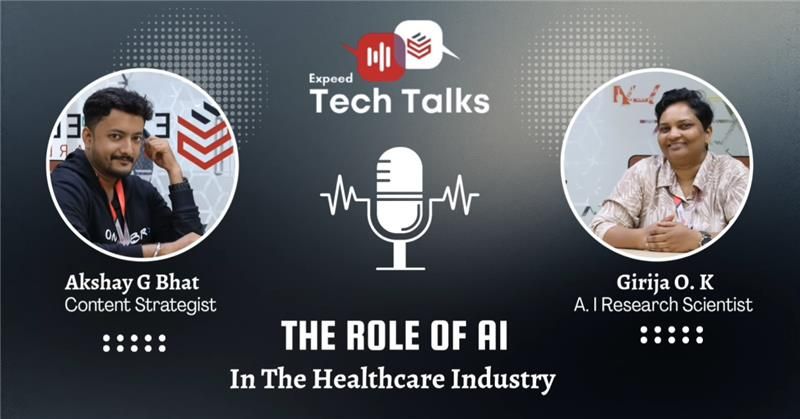This discussion is part of Expeed Tech Talks and the first edition of our series, in which we explore how emerging technologies are shaping real-world systems, decisions, and everyday experiences.
Meet Our Guest

We have the pleasure of speaking with Dr. Girija O.K., an AI research scientist at Expeed Software specializing in healthcare applications. With extensive experience in artificial intelligence and a focus on how it’s driving the healthcare industry forward, Girja brings valuable insights into this important conversation.
In this discussion, we explore AI in healthcare: what predictive healthcare really means in practice, how AI interprets patient data, the challenges of integrating AI into clinical settings, the impact of bias and fairness in healthcare models, and why transparency and regulatory responsibility are so critical as AI becomes more mainstream in this field.
Q&A: Exploring AI in Healthcare
Q: Let’s start with the basics. What is “reactive healthcare,” and how does it work?
Girija: Reactive healthcare is a traditional approach where we seek medical help only after symptoms appear. For example, when you feel sick, you visit a doctor, receive a diagnosis, and begin treatment. It is like repairing a car only after it breaks down. There is very little focus on preventive care. We typically wait for symptoms to develop before taking action.
Q: What are the limitations of this reactive approach?
Girija: While it works for many common conditions, it can be dangerous in the case of life-threatening diseases like cancer, where early detection is crucial and the disease is often curable in its initial stages. But if we wait for symptoms to appear, it may be too late. That’s why moving toward a preventive, predictive model is so important.
Q: How does AI enable predictive healthcare?
Girija: AI analyzes large amounts of healthcare data: medical records, lab results, imaging, and even data from wearable devices. By finding patterns in that data, AI can identify potential issues for the doctor well before symptoms manifest, allowing for earlier intervention and better outcomes.
Q: From a clinical perspective, how does AI assist doctors and medical practitioners?
Girija: AI acts as a smart assistant to doctors by taking care of time-consuming tasks and providing valuable insights. It uses advanced algorithms to extract subtle patterns from medical data such as test results, medical history, and imaging. After analyzing the data, it identifies critical changes or possible health risks and suggests them to the doctor.
It also keeps doctors updated with the latest medical research.
So, AI works alongside the doctor, providing insights. It does not replace the doctor. Doctors still use their experience and clinical judgment to provide care. AI acts as a companion that fills the gap where rapid analysis is required.
Q: What types of data does AI use to make predictions?
Girija: AI systems rely on various data sources like patient histories, lab results, including blood routine tests, imaging scans, and x-ray reports, lifestyle information like sleep and exercise, and real-time data from wearables. It continuously analyzes all this information to predict health risks and support critical care.
Q: Can you explain AI in healthcare from a real-time perspective?
Girija: AI supports critical care by continuously analyzing real-time data such as vital signs, lab results, and information from monitoring devices. When the system detects any sign of an emergency, it immediately alerts medical professionals, allowing doctors to act without delay.
It can also monitor multiple patients at the same time and suggest possible health risks or conditions. This real-time support helps doctors make quicker and more informed decisions.
Q: What are the challenges in adopting AI in healthcare?
Girija: The main challenges are data quality and availability. To make accurate predictions, AI systems require well-labeled and diverse medical data, which may be limited in the healthcare domain. This procedure also includes integrating AI into existing hospital systems, as it often requires technical adjustments and trained professionals to manage the process. The results provided by AI must be transparent and easy for both doctors and patients to understand. Finally, there are costs and infrastructure requirements that healthcare organizations need to consider before adopting these systems.
Q: There’s a lot of talk about bias in AI. How does this affect healthcare?
Girija: AI can inherit biases from the data it is trained on. If the training data is not diverse or balanced, the model may lean toward certain outcomes and overlook others. Suppose, for instance, that there are far more negatives in a dataset than positives. In such cases, the model may assume most patients are negative, even if some are positive. In healthcare, this can lead to inaccurate predictions, which can directly affect patient care. To prevent this, we need datasets that represent different groups, methods to reduce bias during training, and regular audits to ensure the fairness and reliability of a model.
Q: How can we reduce bias in AI models used in healthcare?
Girija: There are several ways to address bias. We can start by developing training datasets that are as diverse and balanced as possible, so different patient groups are fairly represented. Next, bias correction techniques can be applied during model development. In addition, involving experts from different medical and technical backgrounds helps ensure that the system is evaluated from multiple perspectives. These steps together help improve the fairness and reliability of the model.
Q: AI software is audited. What to do to make sure they are all accurate.
Girija: The first step is to review the data used to train the model. The data should be diverse and represent different groups, including variations in age and gender. Then, analyze the performance of the model across each of those groups to see whether the results are consistent.
Any biases in prediction can be identified with the help of statistical methods and different validation tools. In case of detection of any imbalance or bias, adjust the data or apply appropriate correction methods. Further, with the help of evaluation metrics, the model's reliability can be measured.
All findings should be documented in a clear audit report. Even after deployment, the system requires continuous monitoring to ensure that the results remain accurate and fair over time.
Q: What about privacy and regulatory concerns?
Girija: Patient data used for AI involves strict privacy and ethical standards. Regulatory compliances ensure that the AI systems are safe, transparent, and accountable. Building up trust between healthcare providers and patients requires continuous monitoring and legal approvals.
Q: Predictive AI relies on patient data. This raises privacy concerns. What role does regulatory compliance play here?
Girija: Since AI systems use personal health information, they involve ethical responsibilities. Regulatory standards will be required to guarantee privacy, security, and data quality. These standards help protect patient confidentiality and guide how the data is collected, stored, and used. The AI system’s output also needs to be monitored to ensure accuracy. Clear guidelines are required so the results remain transparent and easy for doctors and patients to understand. By following these regulations, trust is built between healthcare providers and patients, supporting the smoother adoption of predictive methods in treatment. Finally, legal approval is required before these systems can be used in clinical practice.
Conclusion!
AI is introducing a meaningful shift in how we think about healthcare. Instead of responding only after symptoms appear, we are moving toward a future where potential health risks can be identified earlier and addressed proactively using predictive analytics in healthcare. Throughout this conversation, we explored how AI supports clinical decision-making, the importance of high-quality and diverse data, the challenges of integrating AI into existing systems, and the need for transparency, fairness, and strong regulatory standards when working with patient information.
This shift from reactive care to predictive and preventive care is not just a technological change; it represents a more thoughtful, informed way of supporting patient health.



